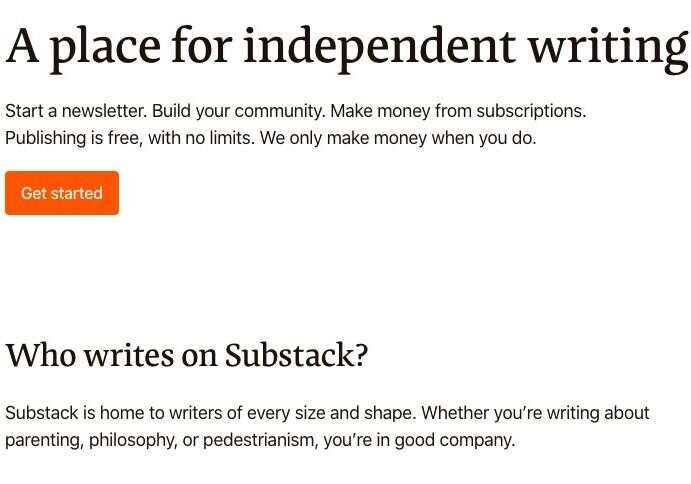
We take a look at how journalists can make money on newsletter platforms such as Substack and Patreon in the latest of a series exploring new ways to make journalism pay. Previous articles have put a spotlight on membership, philanthropy and crowdfunding.
After more than seven years reporting on start-ups and venture capital for the likes of Bloomberg, Eric Newcomer decided it was time to go it alone.
Today, Newcomer’s email newsletter on start-ups (aptly called Newcomer), which he sends through publishing platform Substack, reaches over 1,200 paid subscribers.
“I felt like more people are going to be doing newsletters, so when I saw the trend I thought this was a good time to do it,” he says.
Today, Newcomer says he makes more than he ever did at Bloomberg. (An annual subscription to Newcomer costs $150 a year. After deducting Substack’s 10% cut and credit card processing fees the basic numbers suggest that Newcomer takes home a substantial pay cheque.)
But even with experience at a big name in news behind him and an impressive contact list of sources, Newcomer was unsure how successful he was going to be. He agonised over whether to take the $20,000 advance Substack offered him to help him get started in return for a slice of his profits.
“It was a sign that I didn’t really have a sense of whether I’d make a fair bit of money in the beginning or not,” he says. “It’s super hard to guess what the uptake will be.”
While he values flexibility, landing that scoop or finding exclusive interviews – much easier to come by in a newsroom – is demanding.
“I think about [the newsletter] a lot,” he says.
In recent months a growing number of accomplished writers – including Glenn Greenwald, Vox co-founder Matthew Yglesias and former Digiday editor-in-chief Brian Morrissey – have jumped ship, leaving traditional newsrooms behind to strike out by themselves and use new platforms to raise revenue from their most loyal fans.
There are even entire news outlets, such as US title The Discourse, that are using platforms such as Substack to monetise their audience as pressure on advertising and falling print sales necessitate new ways of raising revenue.
While metrics are not standardised across the various platforms, data from two of the bigger ones suggest that directly reaching out to your own readers to make a living is growing in popularity.
Although Substack does not share statistics on the number of journalists using the platform, the number of paid subscribers has surged since it launched in 2017, topping 500,000 as of February this year.
The number of writers and journalists using Patreon – which allows supporters to subscribe and contribute to creators – meanwhile has almost trebled, as have their combined total earnings.
While there are now a number of platforms that allow individual journalists to raise revenue directly from readers (open source Ghost charges users a monthly fee while Facebook recently entered the fray with Bulletin), Substack, which has so far raised over $80m in four funding rounds from investors such as Andreessen Horowitz and Y Combinator, is possibly the most well-known.
The company, which promises an easier way for journalists to make a living by writing regular newsletters for paying subscribers, was born out of a realisation that “the business model to fund good writing was broken”, says Lulu Cheng Meservey, Substack’s communications chief.
And the promise is deceptively simple.
As a writer, you just focus on your writing and in return for a 10% cut of any subscription fees you make from subscribers (if you don’t make money, you don’t pay) Substack will take care of the rest. Among the services offered to journalists are access to a legal defence fund and training workshops. Journalists also own their content and subscription lists so if they leave the platform they take their subscribers with them.
“[Before] if you wanted to be an independent writer and reach your audience directly, you would first have to jump through a million hoops, you have to learn web design, you'd have to learn all these tech tools, you'd have to own customer support, you have to be your own accountant,” says Cheng Meservey.
But while some journalists such as original substacker Bill Bishop have seen huge success using such platforms to go it alone (the combined earnings of the top ten writers on Substack now total $15m – up from $7m a year ago), the reality of leaving the newsroom is often more complicated.
How journalists are making money on Substack
Although platforms do not share data on individual writers’ earnings, Alice Pickthall of Enders Analysis says large annual earnings are the exception rather than the rule.
“It is a minority making a reasonable amount of money – ones that can command large audiences – and then there’s a very long tail,” she says.
Sian Meades-Williams, who co-writes lifestyle newsletter Tigers Are Better Looking and founded media industry newsletter Freelance Writing Jobs, says that understanding the business side is crucial to successfully going it alone.
"[My publishing sales background] has definitely helped me really understand the commercial side of the industry. Making a living through newsletters is a huge amount of work and it's thankless work that no one sees," she says.
She adds: "I approach my newsletters like small publications in their own right and you're really in charge of everything – from building an audience, scheduling and planning content, and monetising your work. I like to see this as an advantage, but I know the business side of newsletter creation isn't for everyone.
"It doesn't happen overnight. It's hard to create regular content that people will engage with every week. It's work, and the best way to make it a success is to have a plan."
 Promoted white paper: How newsrooms can leverage automation
Promoted white paper: How newsrooms can leverage automation
Read United Robots' 12-page report on newsroom automation: What it is and how it can make journalism better.
Newcomer, who recently spent two and a half days just forwarding his newsletter to all the venture capitalists he knows in a bid to attract more subscribers, says that, for writers signed up to Substack, marketing and business development are also very much down to each journalist.
"I'm a writer – I find writing more natural and enjoyable, but clearly, you talk to any business and they will say marketing is a really good idea. So I should do it more, but it takes time and so I don't do it as much as I should," he says.
While Cheng Meservey says that having a "clear commitment to the writing" and "trying to build quality and build relationships with followers over time" marks out those that succeed, it's hard to escape the reality that a large social media following before striking out – while not always essential – is very helpful.
"It definitely takes a while to build up scale and an audience," says Pickthall. "I think it probably works better for established writers from media outlets who have already built up a following with the security of having a large organisation as well as the salary before they transition across. It would be much harder to build up organically – it's not impossible, but definitely challenging."
Newcomer, who counted thousands of Twitter followers by the time he left Bloomberg, says that while platforms promising direct relationships with readers are sometimes seen as a way for journalists to free their writing from the demands of social media, social media is ironically often the most effective way to build an audience.
"The funny thing to me about Substack is it's a way to escape Twitter and the stupidity of Twitter. But at the same time Twitter is the biggest way to get your stories in front of people who don't already subscribe," he says. "Having an audience that you can bring and then monetise is a more straightforward path."
While platforms such as Substack have clear upsides and downsides for individual journalists, what does their growth mean for newsrooms battling to retain revenue and monetise their own audiences?
"It’s an interesting move and it does benefit certain star journalists individually quite well. But in the context of the wider news industry and in publishing I think it's something that's going to remain pretty marginal," Pickthall says.
While the growth of paid subscribers and supporters on platforms such as Substack and Patreon has been impressive, top subscriber businesses such as the New York Times and the Washington Post still count many times more paying readers.
"The journalists that have done well through Substack are really columnists, political journalists and opinion writers," says Pickthall. "Maybe there's a bit of a risk there that for a news organisation they lose talent – somebody who potentially will be able to leverage higher fees as a result. But media organisations have always competed with one another to retain big names and grow associated audiences. I think it's just another competitor."
Re-bundling – which platforms such as Substack are starting to make possible through the possibility to launch several newsletters and podcasts under a single brand – is, says Pickthall, also unavoidable if such platforms and the journalists using them want to remain competitive with news outlets.
"Re-aggregation is inevitable," she says. "If we imagine that Substack is disaggregating the model of journalism, then bundling is inevitable going forward.
"If you think about, for example, The New York Times Opinion, which is a logical comparator, if you want to get the same amount of high-quality critical journalism from individual Substack newsletters you'd be paying upwards of $100 a month, so the economics of bundling are present and pertinent."
Cheng Meservey says that while there is some overlap, there's space in the industry for both Substack-type models and traditional newsrooms.
"There are writers in this world who should be working in a publication or at a company that are just happy there and that's where they belong, and then there are writers who clearly should be independent," she says. "There's a sliver in the Venn diagram, but the part outside the sliver is really the lion's share and is massive."
[Read Press Gazette's Substack Platform Profile]
Email pged@pressgazette.co.uk to point out mistakes, provide story tips or send in a letter for publication on our "Letters Page" blog
